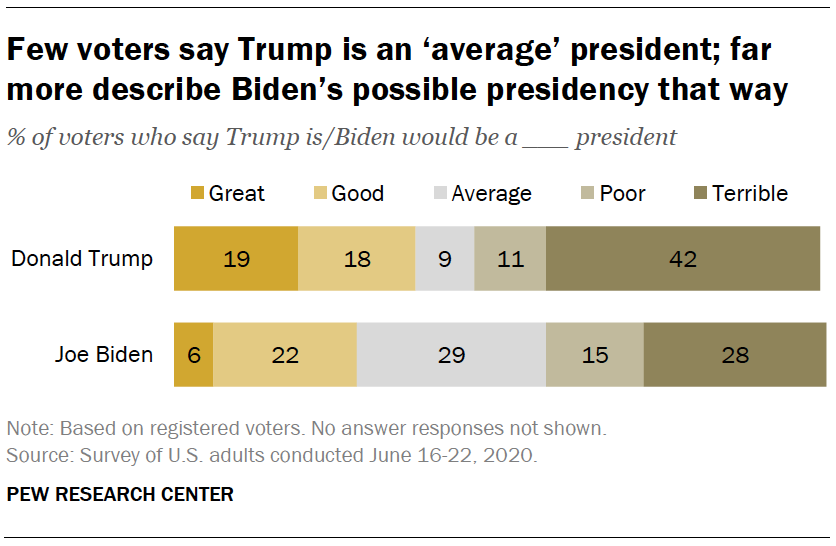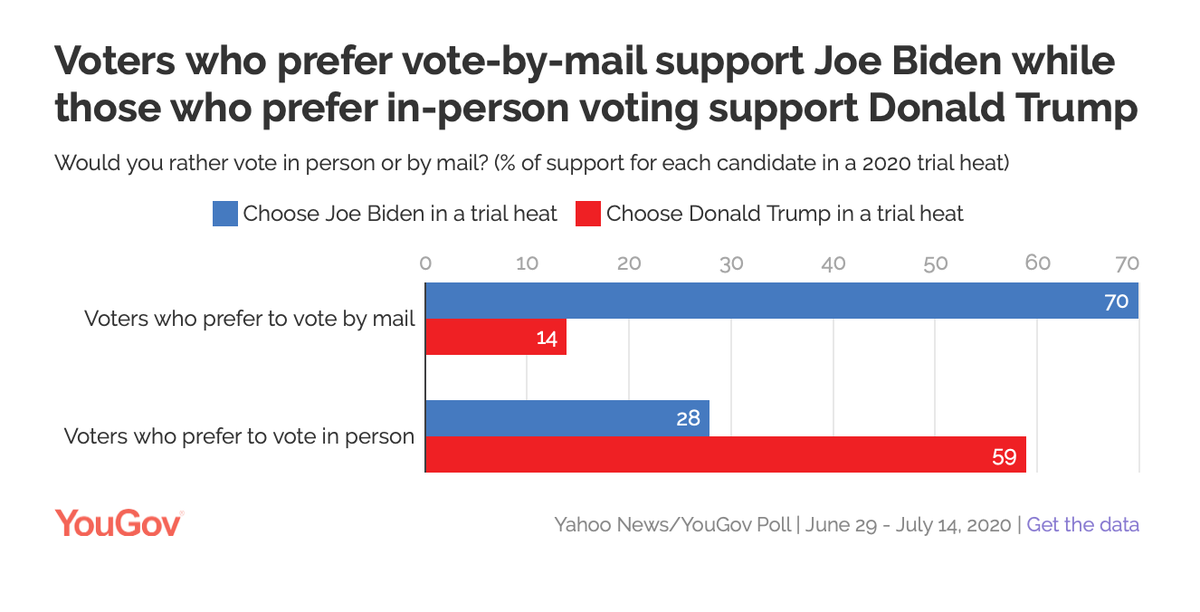THREAD: This week we @PACRONYM announced a major strategic shift toward building enthusiasm for Biden among 1.7m less-engaged, left-leaning voters in AZ, NC, WI, MI, PA, & GA. Georgia? Yep. Coverage here: https://apnews.com/fe78fa8499dfa5bf035393c778c04ac9">https://apnews.com/fe78fa849...
Why? Trump has set a new record as the most polarizing president since Gallup started polling on presidential approval. https://news.gallup.com/poll/245996/trump-job-approval-sets-new-record-polarization.aspx">https://news.gallup.com/poll/2459...
And at this point in the game, even folks who don’t get much news at all have made up their mind on Trump; not so for Biden. More than 75 percent of the *centrist* audience we’re surveying say they couldn’t feel more strongly about Trump. That number is closer to 60% for Biden.
A recent Pew survey likewise found far more polarized feelings about Trump than Biden. https://www.pewresearch.org/politics/2020/06/30/publics-mood-turns-grim-trump-trails-biden-on-most-personal-traits-major-issues/">https://www.pewresearch.org/politics/...
And work by @dbroockman and @jkalla shows that people are still responsive to new information about Biden, but not about Trump. https://osf.io/m7326/ ">https://osf.io/m7326/&qu...
Who are these less-engaged left-leaning voters? These are folks who come home from work and watch entertainment or sports rather than the evening news.
86% of these people did not vote in 2016--many are first-time voters. They are less likely to have a college degree than other voters.
More than 60% of the folks are under 35 and nearly 75% are women. More than 40% of these folks are white, and nearly as many are African-American.
Why this audience? The same reason we’re shifting to pro-Biden messaging. The science says people with weak priors--little pre-existing knowledge/beliefs about X--more often change their views after hearing new info than the well-informed. https://www.scholars.northwestern.edu/en/publications/partisan-bias-and-the-bayesian-ideal-in-the-study-of-public-opini">https://www.scholars.northwestern.edu/en/public...
This is exactly what we& #39;ve seen in the field. After running more than 50 well-powered field experiments, we’ve found again and again that people who are less engaged in politics are more responsive to ads, and particularly responsive to promoted news content.
But more fundamentally, what will make or break this election is whether people put in the effort to navigate voting by mail. A @yougov survey shows just how critical vote by mail execution will be to a Biden victory: https://today.yougov.com/topics/politics/articles-reports/2020/07/17/voting-candidate-preference-poll">https://today.yougov.com/topics/po...
In-person registrations are already way down, so online registration, early ballot requests and early voting will be key. https://fivethirtyeight.com/features/voter-registrations-are-way-way-down-during-the-pandemic/">https://fivethirtyeight.com/features/...
COVID-19 means that localities will dramatically reduce in-person polling places on election day. One extreme case, Milwaukee, WI, had just 5 in-person voting sites for the 2020 primary https://www.jsonline.com/story/news/politics/elections/2020/04/09/wisconsin-election-milwaukee-had-5-voting-sites-while-madison-had-66/2970587001/">https://www.jsonline.com/story/new...
So the first step to overcoming these risks is to turn out a wide swath of the electorate, including folks who may not be as checked-in to politics as the people reading this thread.
What about the electoral map?
What about the electoral map?
COVID also creates uncertainty around how polling will map to election results. Identifying “tipping point” states is much harder, so the ‘battlefield’ is effectively larger.
You have to account for electoral math AND how states execute COVID-19 voting policy--who gets registered, who can complete mail-in ballots, who can vote without waiting in impossibly long lines, and whose ballots are counted.
We’re not only in conventional “tipping point” states--MI, WI, PA (in case we get a repeat of 2016 polling)--but also in close states with up-for-grabs senate seats--AZ, NC, & especially GA, in case the polls aren& #39;t exaggerating Biden& #39;s election-day performance.
But even if the polling data is right on the money, it makes sense to be in a lot of states for a darker reason: the chance of election "irregularities" interfering with the result is far lower. I’ve tweeted about one scenario here: https://twitter.com/SolomonMg/status/1285025715482693633?s=20.">https://twitter.com/SolomonMg...
Think election violence can& #39;t happen here? The AZ Democratic Party headquarters was torched to the ground just yesterday: https://www.usnews.com/news/best-states/arizona/articles/2020-07-24/fire-destroys-part-of-arizona-democratic-party-headquarters">https://www.usnews.com/news/best...

 Read on Twitter
Read on Twitter



